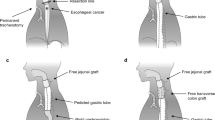Abstract
Background
Total pharyngolaryngectomy and cervical esophagectomy (TPLCE) after chemoradiotherapy remains a challenge because of the high rate of complications and few available data on outcomes and safety. The purpose of this study was to evaluate the clinical significance of salvage TPLCE and to compare treatment outcomes between hypopharyngeal cancer and cervical esophageal cancer.
Methods
Data from 37 consecutive patients who were diagnosed with potentially resectable hypopharyngeal and cervical esophageal cancer after chemoradiotherapy were retrospectively analyzed. The survival and surgical outcomes were investigated between the hypopharyngeal cancer and cervical esophageal cancer groups.
Results
Twenty-six patients were included in hypopharyngeal cancer group and 11 patients were included in cervical esophageal cancer group. The baseline characteristics were balanced between the two groups. Compared to the hypopharyngeal cancer group, the cervical esophageal cancer group had significantly more frequent tracheal-related complications (p < 0.05) and stronger association of distal margin of the cervical esophagus and radiation field with tracheal ischemia after salvage surgery.
Conclusions
Salvage TPLCE can offer the exclusive chance of prolonged survival. Association of tracheal ischemia with salvage TPLCE was seen more frequently for cervical esophageal cancer. Therefore, the indication for salvage TPLCE must be carefully considered to maintain the balance between curability and safety.


Similar content being viewed by others
References
Gkika E, Gauler T, Eberhardt W, Stahl M, Stuschke M, Pottgen C. Long-term results of definitive radiochemotherapy in locally advanced cancers of the cervical esophagus. Dis Esophagus. 2013;27:678–84.
Suzuki K, Hayashi R, Ebihara M, et al. The effectiveness of chemoradiation therapy and salvage surgery for hypopharyngeal squamous cell carcinoma. Jpn J Clin Oncol. 2013;43:1210–7.
Tsou YA, Hua CH, Lin MH, Tseng HC, Tsai MH, Shaha A. Comparison of pharyngocutaneous fistula between patients followed by primary laryngopharyngectomy and salvage laryngopharyngectomy for advanced hypopharyngeal cancer. Head Neck. 2010;32:1494–500.
Dirven R, Swinson BD, Gao K, Clark JR. The assessment of pharyngocutaneous fistula rate in patients treated primarily with definitive radiotherapy followed by salvage surgery of the larynx and hypopharynx. Laryngoscope. 2009;119:1691–5.
Mendenhall WM, Sombeck MD, Parsons JT Kasper ME, Stringer SP, Vogel SB. Management of cervical esophageal carcinoma. Semin Radiat Oncol. 1994;4:179–91.
Carvalho AL, Nishimoto IN, Califano JA, Kowalski LP. Trends in incidence and prognosis for head and neck cancer in the United States: a site-specific analysis of the SEER database. Int J Cancer. 2005;114:806–16.
Saeki H, Tsutsumi S, Yukaya T, et al. Clinicopathological features of cervical esophageal cancer: retrospective analysis of 63 consecutive patients who underwent surgical resection. Ann Surg. 2016. In press.
Miyamoto S, Sakuraba M, Nagamatsu S, Hayashi R. Salvage total pharyngolaryngectomy and free jejunum transfer. Laryngoscope. 2001;121:947–51.
Kadota H, Fukushima J, Nakashima T et al. Comparison of salvage and planned pharyngolaryngectomy with jejunal transfer for hypopharyngeal carcinoma after chemoradiotherapy. Laryngoscope. 2010;120:1103–8.
Chang DW, Hussussian C, Lewin JS, Youssef AA, Robb GL, Reece GP. Analysis of pharyngocutaneous fistula following free jejunal transfer for total laryngopharyngectomy. Plast Reconstr Surg. 2002;109:1522–7.
McCaffrey TV, Fisher J. Effect of radiotherapy on the outcome of pharyngeal reconstruction using free jejunal transfer. Ann Otol Rhinol Laryngol. 1987;96:22–5.
Japanese Research Society for Esophageal Diseases. Japanese classification of esophageal cancer. 2nd English ed. Tokyo: Kanehara; 2008.
Japan Society for Head and Neck Cancer. General rules for clinical studies on head and neck cancer. 5th ed. Tokyo: Kanehara; 2012. pp. 58–65.
Mayanagi S, Onitsuka T, Nakagawa M, Sato H, Kitagawa Y, Tsubosa Y. The use of short segment free jejunal transfer as salvage surgery for cervical esophageal and hypopharyngeal cancer. World J Surg. 2014;38:144–9.
Ajani JA, Bentrem DJ, Besh S, et al. Esophageal and esophagogastric junction cancers (excluding the proximal 5 cm of the stomach). National Comprehensive Cancer Network clinical practice guidelines in oncology. 2015;13(2):194–227.
Teoh AY, Chiu PW, Yeung WK, Liu SY, Wong SK, Ng EK. Longterm survival outcomes after definitive chemoradiation versus surgery in patients with resectable squamous carcinoma of the esophagus: results from a randomized controlled trial. Ann Oncol. 2013;24:165–71.
Bedenne L, Michel P, Bouché O, et al. Chemoradiation followed by surgery compared with chemoradiation alone in squamous cancer of the esophagus: FFCD 9102. J Clin Oncol. 2007;25:1160–8.
Wakui R, Yamashita H, Okuma K, et al. Esophageal cancer: definitive chemoradiotherapy for elderly patients. Dis Esophagus. 2010;23:572–9.
Cooper JS, Guo MD, Herskovic A, et al. Chemoradiotherapy of locally advanced esophageal cancer: long-term follow-up of a prospective randomized trials (RTOG 85-01)—radiation therapy oncology group. JAMA. 1999;281:1623–7.
Minsky BD, Pajak TF, Ginsberg RJ, et al. INT 0123 (radiation therapy oncology group 94-05) phase III trial of combined modality therapy for esophageal cancer: high-dose versus standard dose radiation therapy. J Clin Oncol. 2002;20:1167–74.
Brockstein B, Haraf DJ, Rademaker AW et al. Patterns of failure, prognostic factors and survival in locoregionally advanced head and neck cancer treated with concomitant chemoradiotherapy: a 9-year, 337-patient, multi-institutional experience. Ann Oncol. 2004;15:1179–86.
Salama JK, Seiwert TY, Vokes EE. Chemoradiotherapy for locally advanced head and neck cancer. J Clin Oncol. 2007;25:4118–26.
Takeuchi S, Ohtsu A, Doi T, et al. A retrospective study of definitive chemoradiotherapy for elderly patients with esophageal cancer. Am J Clin Oncol. 2007;30:607–11.
Gardner-Thorpe J, Hardwick RH, Dwerryhouse SJ. Salvage oesophagectomy after local failure of definitive chemoradiotherapy. Br J Surg. 2007;94:1059–66.
Fujiki M, Miyamoto S, Sakuraba M, Nagamatsu S, Hayashi R. Risk factors for tracheal necrosis after total pharyngolaryngectomy. Head Neck. 2015;37:1207–10.
Salassa JR, Pearson BW, Payne WS. Gross and microscopical blood supply of the trachea. Ann Thorac Surg. 1977;24:100–7.
Booka E, Tsubosa Y, Niihara M, et al. Risk factors for complications after pharyngolaryngectomy with total esophagectomy. Esophagus. 2016. In press.
Markar S, Gronnier C, Duhamel A, et al. Salvage surgery after chemoradiotherapy in the management of esophageal cancer: is it a viable therapeutic option? J Clin Oncol. 2015;33:3866–73.
Disclosure
The authors declare no conflict of interest.
Author information
Authors and Affiliations
Corresponding author
Rights and permissions
About this article
Cite this article
Takebayashi, K., Tsubosa, Y., Kamijo, T. et al. Comparison of Salvage Total Pharyngolaryngectomy and Cervical Esophagectomy Between Hypopharyngeal Cancer and Cervical Esophageal Cancer. Ann Surg Oncol 24, 778–784 (2017). https://doi.org/10.1245/s10434-016-5474-y
Received:
Published:
Issue Date:
DOI: https://doi.org/10.1245/s10434-016-5474-y




